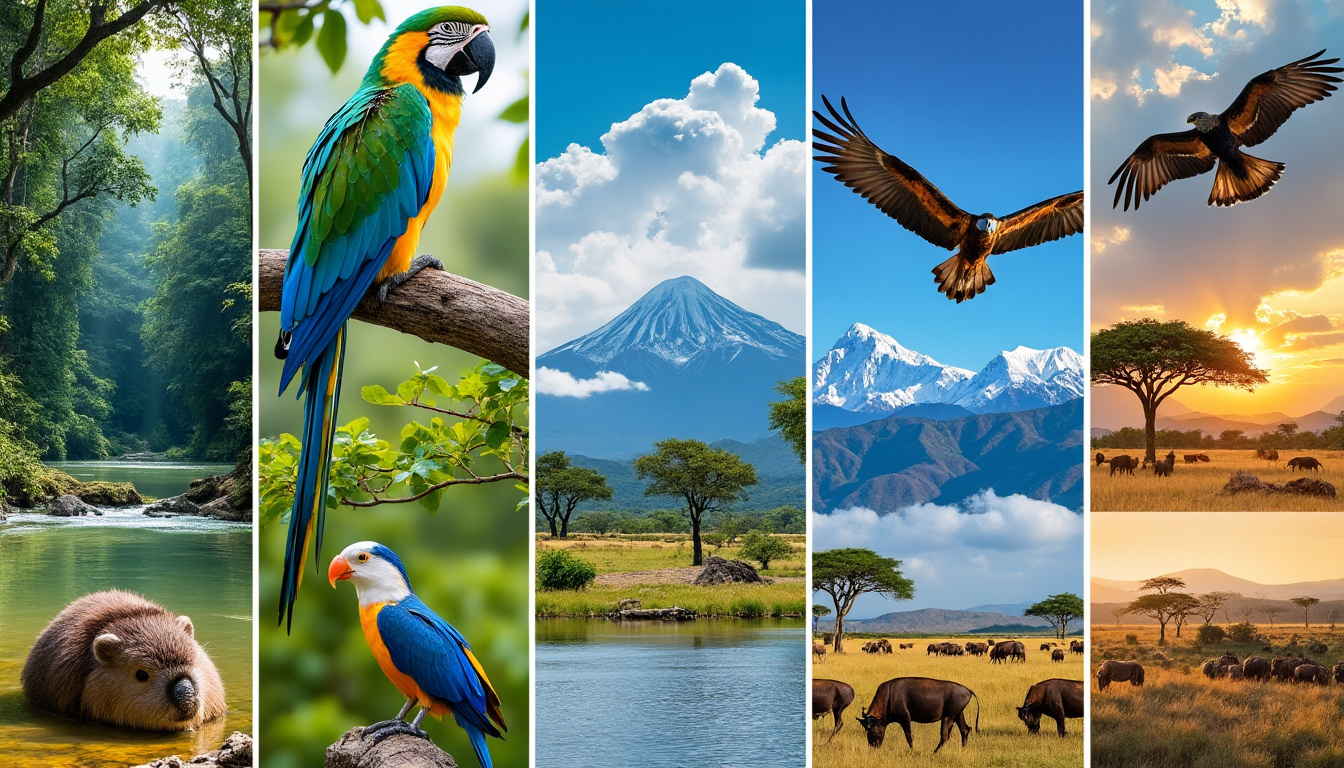Birdwatching has captivated adventurers and nature lovers worldwide, offering an intimate glimpse into the mesmerizing world of avian life. The appeal goes beyond mere observation; it’s a chance to explore diverse habitats, witness extraordinary species, and understand ecological relationships that sustain our planet’s biodiversity. Across the globe, certain locations shine as premier destinations for birdwatchers, each providing unique combinations of species richness, accessibility, and conservation significance. These hotspots are lauded by leading organizations such as the National Audubon Society, BirdLife International, and the Cornell Lab of Ornithology, whose research continues to illuminate the vital role these sites play in global avian preservation. Whether equipped with binoculars from Swarovski Optik, Zeiss Sports Optics, or Celestron, or outfitted by specialty brands like Kakadu Bushwear, birdwatchers are drawn to landscapes that promise unforgettable sightings.
Exploring Biodiversity Havens: The Rich Ecosystems of Borneo’s Sabah Region
Among the world’s most enthralling birdwatching locations, the rainforests of Sabah in Malaysian Borneo stand out for their astonishing biodiversity and ecological vitality. Enveloped within dense tropical forests, these landscapes are home to a dazzling array of bird species, including the elusive hornbills with their signature casques, and vibrant pittas and broadbills that enthrall even the most seasoned birders.
Sites such as the Kinabatangan River and Danum Valley have become pilgrimage spots for birdwatchers seeking to experience rare and endemic species. The Kinabatangan River’s riparian ecosystems host an abundance of hornbills, kingfishers, and waterbirds, providing excellent photographic opportunities amidst the serene natural setting. Meanwhile, Danum Valley’s pristine forest reserve offers uninterrupted tranquility where birders can spot rare species like the Blue-headed Pitta and Helmeted Hornbill, both of which are conservation priorities recognized by BirdLife International.
Birdwatching in Sabah also presents opportunities to engage with conservation programs aiming to protect critical habitats. Collaborations with organizations like the RSPB (Royal Society for the Protection of Birds) encourage sustainable tourism practices, ensuring that future generations will continue to enjoy these avian havens. Practical considerations for visitors include utilizing optics from Vortex Optics or Celestron for variable light conditions found under dense canopy cover.
- Top bird species in Sabah: Rhinoceros Hornbill, Blue-headed Pitta, Bornean Ground Cuckoo, Black-and-Red Broadbill, Storm’s Stork.
- Best times to visit: March to October for the dry season, facilitating easier access to remote areas.
- Recommended gear: Waterproof binoculars, insect repellents, and lightweight outdoor clothing from Kakadu Bushwear.
| Location | Key Species | Accessibility | Conservation Status |
|---|---|---|---|
| Kinabatangan River | Rhinoceros Hornbill, Banded Kingfisher | Boat trips and guided walks | Protected areas with ongoing eco-tourism |
| Danum Valley | Helmeted Hornbill, Blue-headed Pitta | Restricted access, guided tours only | Strict forest reserve maintaining pristine habitat |
Unveiling Europe’s Finest Birdwatching Sites: From Spanish Volcanoes to Coastal Wetlands
Europe offers a striking contrast of birdwatching environments, from the fiery landscapes of volcanic terrain to tranquil coastal wetlands. The continent may not have the population density of tropical avifauna but compensates with a rich variety of migratory and endemic species. Spain, in particular, holds remarkable birding destinations that attract enthusiasts eager to witness diverse avian life alongside breathtaking scenery.
Among Spain’s prime birdwatching gems lie its six eminent volcanoes, which double as natural observation platforms. These volcanic regions, dispersed throughout the mainland and the Canary Islands, harbor birds adapted to specific altitudinal zones and microhabitats. Birdwatchers can spot raptors like the Griffon Vulture and rare passerines such as the Blue Chaffinch. These volcanic sites are spotlighted by nature-focused travel guides like those on Travel to Adventures, which provide essential information on accessing these unique environments.
Meanwhile, Spain’s southern coast presents an altogether different birdwatching experience. The wetland areas, including the Ebro Delta and Doñana National Park, are vital resting points for migratory species crossing between Africa and Europe. Flamingos, glossy ibises, and the endangered Spanish Imperial Eagle soar over these wetlands, enthralling birdwatchers and conservationists alike. Efforts led by the National Audubon Society and local partners have intensified habitat protection, ensuring a continuous haven for these migratory species.
- Key species to watch in Spain: Spanish Imperial Eagle, Greater Flamingo, Blue Chaffinch, Griffon Vulture
- Ideal visiting periods: Spring and autumn during peak migration seasons
- Gear essentials: Spotting scopes from Swarovski Optik, sturdy walking shoes, and weather-appropriate attire from regional outdoor suppliers
| Location | Key Species | Habitat Type | Visitor Tips |
|---|---|---|---|
| Canary Islands Volcanoes | Blue Chaffinch, Berthelot’s Pipit | Volcanic landscapes and pine forests | Guided trekking recommended for safety |
| Doñana National Park | Spanish Imperial Eagle, Greater Flamingo | Coastal wetlands and marshes | Early morning visits for best sightings |
North American Birding Hotspots: From Southern Swamps to Mountain Peaks
The vast and geographically diverse landscapes of North America provide fertile ground for birdwatching pursuits. The southeastern United States, with its expansive wetlands and subtropical climates, and the Rocky Mountains showcase dramatically different bird populations and environmental settings that appeal to both novice and expert birders. Well-supported by organizations such as Birdwatchers Digest and the Cornell Lab of Ornithology, these sites highlight the continent’s ecological wealth.
In the southern swamps, locations like the Everglades in Florida are crucial for observing wading birds such as herons, egrets, and the rare Snail Kite. Efforts to maintain the ecological health of these wetlands continue to be paramount, as the area’s fluctuating water levels influence breeding seasons and species distribution. Complementing such wetland sanctuaries, the higher elevation habitats of the Rockies introduce mountain-adapted species like the Clark’s Nutcracker and Mountain Bluebird. Equipped with optics tools from Vortex Optics or Swarovski Optik, birdwatchers can enjoy crystal-clear views spanning vast vistas.
- Prominent bird species: Snail Kite, Roseate Spoonbill, Clark’s Nutcracker, Black-capped Chickadee
- Prime seasons: Spring and early summer for breeding activity observation
- Preparation tips: Layered clothing for variable mountain weather, insect protection in wetlands
| Region | Key Species | Habitat | Birdwatching Facilities |
|---|---|---|---|
| Florida Everglades | Roseate Spoonbill, Snail Kite | Subtropical wetlands | Guided boat tours and boardwalks |
| Rocky Mountains | Clark’s Nutcracker, Mountain Bluebird | Alpine forests and meadows | Trail access with scenic viewpoints |
African Avian Treasures: Discovering East Africa’s Birdwatching Valleys and Reserves
Africa’s birdwatching scene is a dazzling tableau of evolution and ecological wonder. East Africa, in particular, is home to an array of spectacular birding hotspots, from acacia-studded savannas to lake-lined rift valleys. Renowned for hosting vast congregations of birds, the region draws bird lovers eager to witness unparalleled diversity and iconic species first-hand. BirdLife International and regional conservation partners continue frontline efforts to protect these fragile habitats.
Among the most popular sites is the Serengeti National Park, where migratory birds join the renowned Big Five in a thriving ecosystem. Nearby, Lake Nakuru’s alkaline waters attract thousands of lesser flamingos, creating a stunning palette of pink against turquoise waters. Many of these locations are spotlighted in birdwatching travel guides such as Travel to Adventures’ East Africa birdwatching articles, which provide detailed itineraries and bird ID tips.
Equipped with high-performance optics from leaders like Swarovski Optik and Zeiss Sports Optics, birders can scan the skies and waters for endangered species, including the Shoebill and Grey Crowned Crane. To complement the visual experience, gear from Kakadu Bushwear offers comfort and protection during long hours in sun-drenched landscapes.
- Must-see birds: Shoebill Stork, Grey Crowned Crane, African Fish Eagle, Superb Starling
- Optimal travel windows: June to October during the dry season for optimal visibility
- Essential equipment: Sunscreen, lightweight binoculars, wide-brimmed hats, and durable field guides
| Site | Signature Species | Habitat Type | Visitor Notes |
|---|---|---|---|
| Serengeti National Park | Martial Eagle, Black-headed Gonolek | Savanna and open woodland | Safari tours with expert guides recommended |
| Lake Nakuru | Lesser Flamingo, African Fish Eagle | Alkaline lake and surrounding forests | Photography hides available for closer views |
South American Avifauna and Ecotourism Gems: Exploring Costa Rica’s Lush Bird Habitats
Costa Rica has earned a world-renowned reputation as a birdwatching paradise nestled within Central America. With over 900 bird species recorded, the country’s landscapes range from cloud forests to coastal mangroves, offering unparalleled variety and accessibility. This impressive biodiversity spotlights species like the Resplendent Quetzal and Scarlet Macaw, which attract nature tourists and professional ornithologists alike.
The country’s national parks, including Monteverde Cloud Forest and Corcovado National Park, have become epicenters for ecotourism, with meticulously maintained trails, guided tours, and educational programs supported by groups such as the National Audubon Society and the local Birdwatching Association. This blend of conservation and tourism ensures lasting protection for habitat and species diversity.
Effective birdwatching gear, particularly lightweight but robust optics from brands like Vortex Optics and Celestron, are highly recommended to capture the vibrant plumage and elusive movements of tropical birds. Additionally, Costa Rica’s tourism infrastructure facilitates easier planning through resources such as comprehensive bird-watching travel guides that detail prime locations and travel tips.
- Highlight species: Resplendent Quetzal, Great Green Macaw, Keel-billed Toucan, Three-wattled Bellbird
- Optimal months: December to April for dry season bird activity
- Recommended equipment: Portable spotting scopes, eco-friendly insect repellents, breathable clothing
| Park | Featured Birds | Habitat Characteristics | Visitor Facilities |
|---|---|---|---|
| Monteverde Cloud Forest | Resplendent Quetzal, Three-wattled Bellbird | Montane cloud forest | Guided night and day tours |
| Corcovado National Park | Great Green Macaw, Scarlet Macaw | Tropical rainforest | Eco-lodges and canopy tours |


